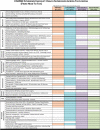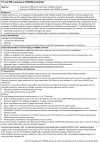Guidelines in CHARGE syndrome and the missing link: Cranial imaging
- PMID: 29168326
- PMCID: PMC5765497
- DOI: 10.1002/ajmg.c.31593
Guidelines in CHARGE syndrome and the missing link: Cranial imaging
Abstract
"CHARGE syndrome" is a complex syndrome with high and extremely variable comorbidity. As a result, clinicians may struggle to provide accurate and comprehensive care, and this has led to the publication of several clinical surveillance guidelines and recommendations for CHARGE syndrome, based on both single case observations and cohort studies. Here we perform a structured literature review to examine all the existing advice. Our findings provide additional support for the validity of the recently published Trider checklist. We also identified a gap in literature when reviewing all guidelines and recommendations, and we propose a guideline for neuroradiological evaluation of patients with CHARGE syndrome. This is of importance, as patients with CHARGE are at risk for peri-anesthetic complications, making recurrent imaging procedures under anesthesia a particular risk in clinical practice. However, comprehensive cranial imaging is also of tremendous value for timely diagnosis, proper treatment of symptoms and for further research into CHARGE syndrome. We hope the guideline for neuroradiological evaluation will help clinicians provide efficient and comprehensive care for individuals with CHARGE syndrome.
Keywords: CHARGE syndrome; CHD7; CT; MRI; guidelines.
© 2017 The Authors. American Journal of Medical Genetics Part C Published by Wiley Periodicals, Inc.
Figures



References
-
- Abadie, V. , Wiener‐Vacher, S. , Morisseau‐Durand, M. P. , Poree, C. , Amiel, J. , Amanou, L. , … Manac'h, Y. (2000). Vestibular anomalies in CHARGE syndrome: Investigations on and consequences for postural development. European Journal of Pediatrics, 159, 569–574. - PubMed
-
- Arndt, S. , Laszig, R. , Beck, R. , Schild, C. , Maier, W. , Birkenhager, R. , … Aschendorff, A. (2010). Spectrum of hearing disorders and their management in children with CHARGE syndrome. Otology and Neurotology, 31, 67–73. - PubMed
-
- Asakura, Y. , Toyota, Y. , Muroya, K. , Kurosawa, K. , Fujita, K. , Aida, N. , … Adachi, M. (2008). Endocrine and radiological studies in patients with molecularly confirmed CHARGE syndrome. The Journal of Clinical Endocrinology and Metabolism, 93, 920–924. - PubMed
-
- Asher, B. F. , McGill, T. J. , Kaplan, L. , Friedman, E. M. , & Healy, G. B. (1990). Airway complications in CHARGE association. Archives of Otolaryngology‐Head and Neck Surgery, 116, 594–595. - PubMed
-
- Bauer, P. W. , Wippold, F. J., 2nd , Goldin, J. , & Lusk, R. P. (2002). Cochlear implantation in children with CHARGE association. Archives of Otolaryngology‐Head and Neck Surgery, 128, 1013–1017. - PubMed
Publication types
MeSH terms
LinkOut - more resources
Full Text Sources
Other Literature Sources
Molecular Biology Databases
Research Materials
Miscellaneous

